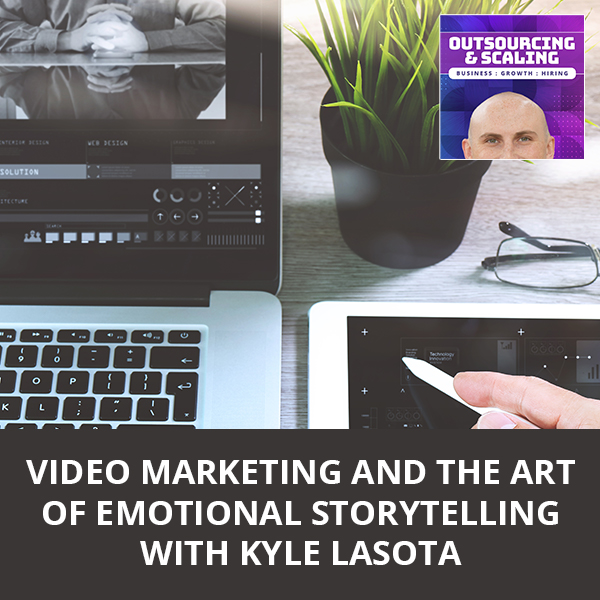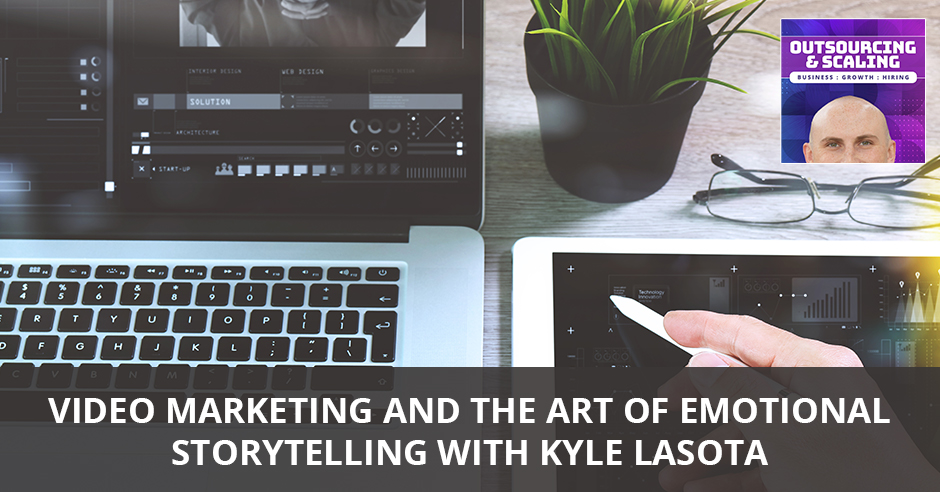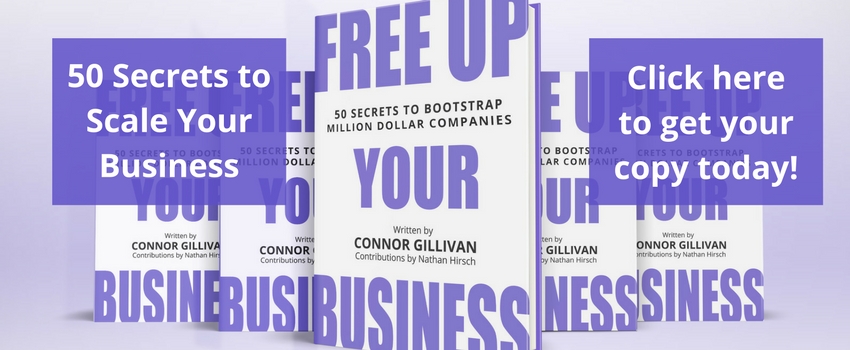


In today’s podcast, learn the struggle before the success of Kyle Lasota, the owner of Kylegotcamera.com as he opens up about his wake-up call to start living with a purpose through video marketing. He shares his four-step method to help entrepreneurs who want to create impact tell their story to the world. With a growing business, Kyle had to dip his toes to outsourcing and move to relearn communication and to manage people in an entirely new way. He is now on a mission to build the world’s largest community of videographers.
—
Listen to the podcast here:
[smart_track_player url=”https://www.podetize.com/statsapi/www.podetize.com/wp-content/uploads/fileuploads/11-5b145ef137b51b3d1af0633e9305c43d/09/2019/b8311fd2133a144eb7d6aff83addc62f.mp3″ title=”Video Marketing And The Art Of Emotional Storytelling with Kyle Lasota” artist=”Nathan Hirsch” image=”https://freeup.net/wp-content/uploads/2019/04/OAS.png” ]
Download the audio file here.
Video Marketing And The Art Of Emotional Storytelling with Kyle Lasota
I’m here with Kyle Lasota. Kyle, how are you doing?
I’m good. How are you?
I’m doing great. We met at the rooftop in San Diego for Traffic & Conversion. It’s been a lot of fun getting to know you. I know that the audience will love to hear your story as well. For those of you that don’t know, Kyle is all about video marketing and storytelling, taking the internet by storm, generating over $30 million in sales from his videos, working with people like Sam Ovens, Scott Oldford, Paul Getter and many more. He’s on a mission to build the world’s largest community of videographers. Kyle, we’re going to talk all about that. Let’s take a gigantic step back. I know you’re still young, but what were you like growing up? Were you a rebel or were you a Straight-A student? Did you know you wanted to be an entrepreneur?
I was always an entrepreneur. I just didn’t know what that meant. I was a little bit of a rebel. I got nominated in high school like most likely to succeed, most likely to do this and that. Mine was the biggest rebel without a cause ironically. My first venture was selling muffins in front of Blockbuster. After that, I started selling Swishers to the kids who smoked weed because I had an older brother who could get Swishers and everyone wanted to smoke blunts. I got into throwing parties. I remember I threw this event. It was anything but close dance party. My parents didn’t know what that was. I called it an ABC party. They let me rent a venue, get an insurance policy, hire a DJ, hire bouncers and do everything. They co-signed on whatever it needed to be co-signed. I remember we sold the water for $2 a water inside. It was $15 to $20 to get in.
I had my promoter friend invite everyone. The venue could only fit 200 people and there were 300 people at the venue. We had a line of 100 people out the door. I remember walking away that night with $3,000 in cash profit and laying it out all on my kitchen table, counting all my money. It looked like a drug scene from a movie. Being, “This is incredible,” that I felt this rush of like, “This is amazing.” I worked two jobs, which was at a Lacrosse store because I was on the Lacrosse team. I worked at Restoration Hardware in my first summer back from college. I remember I showed up late to work one day and my boss was like, “If you ever show up late again, you’re fired.” Right then and there I was like, “I’m never going to be in a position where someone is telling this type of thing to me ever again.” I always had a problem with authority and all these different things. It’s the classic entrepreneurial beginnings.
I’ve heard you talking on the roof. You’re like, “I have a weapon and the video camera is my weapon.” How did you get to that point? Walk us through that. Why the video camera? How did you learn to do what you do?

In high school, I took photography because it was an easy class and I heard it was fun. When I got into it, I started enjoying it. I started liking making photos. For my senior project, I was in AP photo, which is a thing. I made a video. It was like a rap music video about the AP photo class with a couple of friends. It was fun. In middle school, I was always making videos with my brothers and his friends. I was the one who would edit it on iMovie and I got suspended from school because I did some inappropriate stuff in editing on my school computer. There was something about making videos and creating that I lost myself in it and I always had a talent for it. The rhythm thing made sense to me.
When I was applying to go to school, I decided I’m not going to do business because that seems like a cop-out to get a business degree. You can’t learn business in school. Intuitively, I already knew that. I was like, “What am I never going to get bored of?” The only thing that I knew where I could do it on and on was videos. I applied to film school. I got into one. I went to Colorado CU Boulder. I studied film and entrepreneurship at this school. The problem with the film school is I never learned much about making stuff. It was all film studies, film history, all this stuff that was irrelevant to me. All I wanted to do was pick up a camera and start making stuff.
I saw some stuff happening with the people who had gone through the film program and they were all broke. The guy who was developing my film from one of the projects I was working on, he was a film major at CU. My teacher was a film major at CU. I started seeing this pattern of all these filmmakers don’t have any money. That’s why they’re a teacher. That’s why they’re working at the camera store or whatever. I said, “I need to figure out a business and I’ll go back into video.” It’s 50% business, 50% talent. I went into network marketing, I learned about sales, personal development and all this stuff. I sold and recruited 1,000 people into my organization in eight months with the help of a friend of mine. I was on cloud nine. I was like, “This sales thing, this business thing, this is like where I belong.” I dropped out of school, quit the network marketing company because I got a job in investment banking. I thought like, “If I go to investment banking, I’m a good salesman, I could make a lot of money fast.”
I also thought at the time I wanted to raise money for a company. I wanted to see what it was like on the other side. That was horrible. Working at an investment banking firm is like, “I wouldn’t wish that upon my worst enemies.” I did it for six months and worked at two different firms. The short story of the long story is when I quit that firm, I was looking for an opportunity. I’d met a friend, he was making a bunch of money online. He said, “Come out to Miami, come learn how to do this and you can run our company.” He had this media company. It was a Clickbait-y stuff on Facebook where he was buying likes on fan pages, sending traffic to the site and making money through ads. It was when organic reach on Facebook was huge. I learned how to do copywriting. I started writing headlines. I got good at it. All of a sudden, now I’m making money online. I’m driving all this traffic and it’s working. I wrote six to eight headlines every day for two or three years.
Another company hired me as a consultant to start writing copy for them. Russell Brunson heard about me and he hired me to write the headlines for his book, Expert Secrets. My copywriting career started taking off. The only problem is I had left this whole filmmaking thing in the background. The stuff that I was doing, I was making money, but it was starting to not feel very good. My awareness around the impact and ramifications of the stuff that I was writing, what it meant to me and its effect on other people started seeping in. I kept ignoring the voice because I was so focused on making the money. I was scared of taking a chance on myself and going for the video thing. That all came to a head and I got stressed out. I was writing 100 headlines a day. I was making more money than I knew what to do with at the time, but I was working myself into the ground. I was doing something that I didn’t enjoy.
Also, I was going out a lot. I was drinking. I was mistreating my body. I burned. I started having panic attacks and started having anxiety attacks. I started having stomach problems and skin problems. All these weird symptoms that were seemingly unrelated but also happening at the same time. No doctor could tell me what was going on. My immune system was going down. All these weird things were happening, then it blew up. I was like, “I can’t take this anymore.” I broke the lease on my apartment. My brand new apartment in Newport Beach that I had moved into, I left those companies and I moved back in with my grandma to heal and to rediscover what it is that I need to do. Somewhere in my journey, I read somewhere online that the reason why I was experiencing all those health challenges and symptoms was that I wasn’t “following my purpose.”
[bctt tweet=”When you do something that fulfills you and is aligned with your purpose, everything falls into place.” via=”no”]
I knew as soon as I read that, I was like, “I have to pick up a camera.” I picked up a camera. I started making videos and I landed my first client. I had to position things in a way where it was like a high ticket. It was specialized so that I didn’t get commoditized like the other videographers because I was traveling crazy. I had too many clients, it would become stressful. It would hurt my health in the way that I had become sensitive. That’s how I got into video. From there, when you’re filled and driven through something that you believe is your purpose like God in the universe is on your side and everyone is rooting for you.
I had all types of favor. Things would line up for me. I get this one client. That client would lead to all these other clients. My very first client ended up making over $30 million with the videos that we did together. That’s only one client. That’s the only stuff that I can track. I had been very humbled over the course of the journey of people receiving the work that I do, the art that I create and have it work from a marketing context as well. It’s been this ever-evolving journey of finding the right mentors, lowering my stress, getting my health back in check, and also doing work that fills me up in and hopefully inspires people to do something great.
First of all, thanks for sharing that story. That was very powerful. A lot of entrepreneurs can relate to being stressed and having that affect their health and maybe making some bad decisions. Seeing you recover from it is awesome. Talk to me about your style of videos that you produced. I’ve seen your videos. They’re awesome. I’m not a videographer. It’s tough for me to put them into words. What type of style do you go for? What do you call it?
I haven’t coined this term, but it is a term that I use a lot. I call it the emotional story selling. It’s like this hero’s journey of the entrepreneur. It’s them telling their why and articulating a message that is embedded with that why about their journey as an entrepreneur and the real reason behind why they do what they do. We use that strategically to enroll our ideal client into our products, our service, our programs or whatever it is. In addition to that, we also do some positioning stuff to make the entrepreneur look like the top expert in this space based on their unique value proposition and also their way of seeing the world, their perspective on the market.
The best products in the world usually have the worst marketing because all their time is being spent on the products and their business only grows as a product of their focus on the product. Something that’s a hidden agenda of mine is to find these products that are the best products in the world and help tell the story of those products or of those entrepreneurs to get those out to the world. If they had good marketing, there would be Fortune 500 companies. The reason why a product like Apple is so big and successful is because the product is amazing. iPhone is an amazing product. Apple computers, they’re amazing. The marketing is on point. The branding is dialed in. They tell the stories so well. Hence, you have an amazingly successful company.
I know that there are thousands, if not hundreds of thousands, if not maybe even millions of companies out there that are amazing products, services but they’re not telling this story the right way. They’re not positioned the right way or the quality of the brand doesn’t look that aesthetically good. The videos that I help people create are, “Let’s make everything look good, cinematic, let’s position it well. Let’s make sure the message is dialed in.” Also, it has to be authentic to who you are, what you stand for and what you’re trying to create in the world so that you feel represented, you feel seen. Your perfect customer, the person that you’ve created this product for, when they see that story, when they see that message when they see that video, it’s like, “I don’t know why, but I have to buy this because it’s resonating on a deep soul level of in it.” That’s a long-winded way to describe it.

Can you talk a little bit about the process? I remember I saw Andrew, which I believe you did some work for. I saw on his story that he had some videos of you doing some different filmmaking. What does that process look like? I’m assuming you sit down and meet with them. You fly out to them and eventually, there’s editing involved. Can you walk people through what that whole process looks like from a creative standpoint?
It’s funny how the parts of our journey you can’t connect the dots looking back. Me going into copywriting, me learning about marketing, messaging and all this stuff, getting people to click, getting people to convert has set me up to serve my clients in an amazing way. I take a copywriting approach to how I work with my clients. Meaning, we reverse-engineer the story that needs to be told based on the data that we collect from their avatar of their ideal clients. We do a deep dive into their avatar. You may think you know your perfect customer, you sit in the room with me and you have a whole other level of understanding of who you want to serve.
If you had 100 or 1,000 or 10,000 perfect dream customers, I’m sure your life would look a lot different than it does right now. A lot of times we get customers, they’re not always perfect. They are not always ideal, but what if we could craft a message? What if we could tell a story that speaks exactly to that person that we love and get lit up by? That’s the first step, “Let’s get clear on this perfect customer avatar thing.” That gives me the data that I need to bring the right questions into the interview. Once you give me the data, you don’t need to do anything. We need to meet. The first day we sit down and we do an interview. I have the questions in my head based on the process that we went through in the beginning.
I ask you the question so it’s just a conversation. We have that conversation and I know that there are certain elements of a story that need to be incorporated in order for the story to be effective. The elements that I use are the dream, setup, the fall and the resolution. If we have those four components, we know that we can have a good story. The dream is, “I want it to be a videographer.” The setup was, “I found out all videographers were broke, so I went into business.” The fall was, “All of a sudden I started having health problems, panic attacks and everything were falling apart.” The resolution was, “I picked up a camera and I started telling stories, making videos and I healed.” I use that framework where I told my story and that’s how I look at it with every other entrepreneur that I work with.
It’s, “Let’s get the right data. Let’s create these components within the story that already exists within you.” I’m going to pull those out. The rest of the time we’ll shoot some ads. We’ll create some retargeting assets, so you don’t have any holes in your funnel. The next day is like B-roll. We go shoot a bunch of cinematic B-roll that visually represents the story that you told. We place that B-roll on the top of the story and there we go, we have a beautiful emotional story selling package that it makes you omnipresent. It helps you connect with your audience. It’s going to increase your show up rates on your sales calls and your conversions on the backend. It’s also going to build brand awareness in a way that moves the mission forward and enrolls other people into it.
I kept developing it over time. At first, it was like, “This is just a story video.” It’s like, “I would work with a client and not enough people would see the story.” I’d be like, “We’re doing a Facebook ad,” but I’m like, “You don’t know if that Facebook ad is going to convert. Let’s do nine different split tests, no matter what you’re getting traffic to this video.” After that it was like, “You’re getting traffic to the video but your numbers could be increased along the sales funnel. Let’s increase the conversions. Let’s make you omnipresent by creating some retargeting ad.” Anytime someone falls into your funnel, they don’t fall out. They come back in. We become meta-famous to our perfect customer.
[bctt tweet=”You don’t have a business if it doesn’t make money when you’re not there. ” via=”no”]
With all these things in place, sequentially, we have wholeness in our marketing. There are no gaps. We’ve got the frontend. We’ve got the middle of the funnel. We got the backend. It slowly evolved into this process of, “How do I deliver so much value that for my ideal client? When we get on a sales call and I tell them the prices, that’s it.” For that much value, that’s how much it costs. It should be so lasered in that my ideal clients should be throwing their credit card at me. That’s what I’ve been trying to develop and that’s what I’ve felt I’ve come to now. When I meet the right person, when they see what my offer is, when they see how I can help them, it’s like, “Let’s go.”
You have met a lot of videographers. Where do you think they would go wrong in the process? You mentioned it a lot that they’re broke or they’re struggling. You’ve had a lot of success. You’ve seen a lot of videos. Where do they go wrong?
There are two big ones. Number one, the video looks good, but the message isn’t dialed in. The other one is the message is dialed in, but it doesn’t look very good. We want both. They also get it wrong in the sense that they don’t understand how to solve people’s problems. They’re trying to push their agenda which is, “I want to make videos.” When you have a client, you need to think about what their needs are. When you’re a videographer and you’re working with clients, it’s not about you. It’s about you when you go off and make your own stuff. That’s your time to be creative and all this stuff. When you’re working with a client, they are hiring you to solve their problems and that’s it.
This is the Outsourcing And Scaling show. I want to talk a little bit about hiring. When I met you on the rooftop, you’re like, “I’m ready. I’ve got to start delegating. I want to scale this thing. I’ll give you some free outlet.” I know you’ve gone through the VA process for the first time. Talk to me about that because I feel the mentality that you have to delegate is something that not a lot of entrepreneurs get to or realize or take control of.
I’m in a unique scenario in the sense that with all the health stuff going on and with the type of lifestyle that I’m trying to create, I came to the realization that my new definition of business is you don’t have a business if it doesn’t make money when you’re not there. I have been going through this paradigm shift of letting go of everything. I’m on a mission to eliminate all my work. I’m on a mission to only work an hour a week. I’m pushing my belief of finding meaning inside my business and searching for meaning outside my business, which is counterintuitive to what a lot of entrepreneurs say, think and believe. I am a contrarian. I believe that if everyone is saying one thing, then I should do the other thing or do the opposite.
If everyone says, “You should build this business or you find your purpose in your business and your mission,” I’m going to say the opposite. I’m going to say, “No, your business is a vehicle there for you to make money and it’s up to you. Once you get on the other side of what it means to be financially free, then you are open to what is possible.” Until you get it on the other side of that, you’re clouded by cognitive biases. My decision to start hiring people is, “If I’m truly committed to only working one hour a week, some things need to change.” Number one, I need to start systematizing everything and I need to start tracking everything. I need to start documenting everything. I need to start making training so that I can bring someone on to take on this position.

It started off with me hiring someone to map out all my systems. Everything is clean, but anytime I have a sales funnel, someone fills out an application through a schedule. Once that goes to a sauna, that goes to a custom CRM that’s built in a sauna who automatically gets assigned to someone. In the future, it will be a salesperson. Once that person gets sold, they’d get tagged in an operations thing inside of a sauna, which gives a dropdown menu with a checklist, with every single step of the project management are laid out with all the resources, all the documents, every single piece of the business and steps that need to be taken in order to move the client down. The process of our fulfillment is all laid out. Once I built that out, I was like, “This is great. I have the systems, but I was still doing all the work. I was so overwhelmed. Now I need to hire someone to work the system.”
The first step is to map everything out. The second step is to put someone in to run through it to see if it functions and works when you’re not doing it. With the feedback of that person, you can refine it and get it better and better to the point where someone else can do it without you. The first step for me was like, “I need to get the basic level stuff that I hate off my plate so that I can start focusing on the higher level stuff that’s going to move the needle forward towards getting to this one-hour a week workweek.” The first step for me is admin, social media, project management, all the backend stuff that doesn’t fit my personality type, which is frontend like sales, marketing, client management and the actual strategy of the actual fulfillment. Admin was the first thing. I met with you, Nathan. You said, “I got this thing. You can hire someone.” I’m like, “Let’s do it.” It’s scary for me, but I’m going to do it anyway because I know it’s necessary. It’s going to be painful. I know it’s not going to be perfect, but I’ve got to get her in there.
I went on FreeeUp. I hired this VA. I sent all my applicants a test to make me a daily brief for all my KPIs, all my messages. I would consider it the pulse page of my business, all the key metrics that are important for me to keep an eye on. She blew it out of the park with the level of detail that she went to. I was like, “She got this level of detail and this level of admin skills. This is the one.” I chose her and now I’ve been training her on how to build standard operating procedures from a Loom video that I make, which is a software where I record videos to make a training. Now, anytime I’m doing something during my day-to-day at work, I’m recording it on Loom as a training video. I’m archiving it and I’m going to send it to her where she can write out a standard operating procedure for it. She can put it in what’s called a Playbook. A Playbook is like a master spreadsheet that houses all your documents, all your resources and anything that anyone on your team could ever need is all in one place. It’s crazily integrated. It sounds complex, but it’s amazing.
That’s where I’m at right now is I’ve gotten to the point where I can send her a Loom video. She can write a procedure that’s so detailed that someone who’s not in my company, who doesn’t even know how to do any of the technical stuff. If they could come in and will go through this procedure, they could execute the procedure themselves without any prior knowledge training or experience. That’s the level of detail that I’m going to and that’s what my assistant is helping me do. Once those are mapped out for all the stages of my business, then you’ll hire an editor, then you hire an assistant videographer, then you hire a project manager and it’s done.
What have you learned from working with the VA for the first time? I’m assuming that’s the first time you worked with a Filipino VA. Were there any lessons along the way?
Over-communicate is the first thing that comes to mind. Definitely over-communicate, double-check and confirm that they understand what you’re asking of them. Make sure that they’re set up for success. When I first hired mine, it forced me to put a lot of stuff in place. I don’t think that’s the best practice. You should have some stuff in place, have a plan to how to onboard them. Set expectations well from the beginning. Let them know when you want them to be available, when you won’t need them to be available and be clear about what the outcomes are that you’re looking for and how you want to develop the working relationship. I would say the biggest lesson is taking the time to understand yourself and understanding what are your needs that may be totally unrealistic. Also, what are the things that you are inside your head that aren’t out there on paper? You do without even thinking about it but would need proper explanation for someone to understand.
Kyle, you’ve provided a lot of great information for the audience. Is there anything else that you want to share, maybe for the video editors out there or videographers or maybe other clients in the space? Anything that we didn’t cover?
With videographers, I would say double your price whatever you’re charging. Number two would pick a niche and go deep within that niche. I would create an offer that’s productizable, meaning you can repeat it over and over again. You can turn it into a system. The problem with most videographers is that they’re freelancers. They’re doing everything for everyone under the sun. You need to go from being a generalist to being a specialist. When you become a specialist, you can raise your prices. Your clients will be happy. People will seek you out instead of you seeking them out. I love this question by Tim Ferriss, which says, “What if you did the opposite for 48 hours?” If you have a way of doing things, what if you did the complete polar opposite for 48 hours? That deep-questioning process will help create leaps and bounds for your happiness, for the business growth, for everything that you’re trying to achieve. It’s like asking better questions of, “How can I make a cake and eat it too?” The first question for me was, “How do I have a videography business that doesn’t kill me and isn’t stressful?” The way that I did it is by asking that question and the answers appeared.
Kyle, where can people find out more about you and what are you most excited about for the rest of the year?
You can find me on Facebook, YouTube and Instagram, @KyleGotCamera or @TheGotCameraCrew. I’m excited about this community that I’m building of videographers called The Got Camera Crew. I’m essentially teaching them how to grow their business and all this stuff that I’ve learned along the way. The goal was to grow the largest, most engaged community of videographers in the world so that we can all create for ourselves and for fun. You can only do that if you have the money and you have the time. I want that for you. I also want that for myself. It’s very selfish because creating for yourself is great, but creating by yourself can get lonely. I want people to create with. In order to do that, I’ve got to help everyone rise. There’s a Facebook group, join the Facebook group,
Check out what Kyle is up to and join the Facebook group. Kyle, I’m excited to work with you. I love working with you. I’m excited to see what you’re up to for the rest of the year. Thanks so much for coming on.
Important Links:
- Kyle Lasota
- Traffic & Conversion
- Expert Secrets
- FreeeUp
- Facebook – Kyle Lasota
- YouTube – Kyle Lasota
- @KyleGotCamera on Instagram
About Kyle Lasota
 Kyle Lasota is a 25 Video Marketer And Storyteller Taking The Internet by storm. Generated 30+ million in sales from my videos. Worked with people like Sam Ovens, Scott Oldford, Paul Getter, and many more. On a mission to build the world’s largest community of videographers.
Kyle Lasota is a 25 Video Marketer And Storyteller Taking The Internet by storm. Generated 30+ million in sales from my videos. Worked with people like Sam Ovens, Scott Oldford, Paul Getter, and many more. On a mission to build the world’s largest community of videographers.
